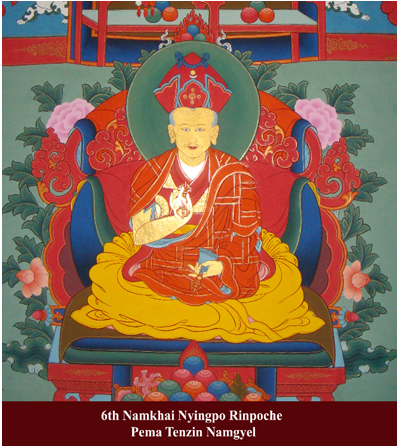Namkhai Nyingpo Vi
HOME / Namkhai Nyingpo vi
Nub Namkhai Nyingpo
Namkhai Nyingpo was a revered bhikshu who dedicated his life to the practice of fierce yogic discipline in the grand cave of Lhodrak Kharchu. His unwavering devotion led him to achieve Siddhi and receive teachings and empowerment from an Indian Master named Humkara. Through his divination skills, he saved King Trisong Deutsen from illness, earning him respect and admiration from many. However, his good deeds did not go unnoticed by the Queen and Bon ministers, who exiled him from his homeland. Despite being forced to leave, Namkhai Nyingpo remained steadfast in his devotion and had a vision of a Wisdom Dakini, which led him to disguise himself as a mendicant to locate her. During his lifetime, he composed many tunes attributed to various puja incantations, which continue to inspire and move people to this day. He also performed miraculous feats, including holding the sun still, displaying his attainment beyond physics. Namkhai Nyingpo’s aspirations for the benefit of all beings continue to inspire us today. His journey serves as a reminder that dedication, perseverance, and faith can lead us to achieve great things in life, regardless of the challenges we may face.
 Namkhai Nyingpo VI | Pema Tenzin Thrinley Namgyal Pelzangpo
Namkhai Nyingpo VI | Pema Tenzin Thrinley Namgyal Pelzangpo
The Sixth reincarnation, Pema Tenzin Thrinley Namgyal Pelzangpo, was born in Lhodrak Zha in 1894. He had memories of his old monastery from childhood and left a footprint on a stone that revealed his identity. He received his ceremonial haircut from scholar Bakha Rigzin Khamsum Yongdrel and was named Pema Tenzin Thrinley Namgyal.
In 1960, while teaching in Bumthang, a teacher showed miraculous powers to monks. He also gave profound teachings during his stay at Sangda Dorji Bechen’s retreat and appointed a principal at Kharchu. He passed away in 1961, and his body was mummified. His disciples gathered to pray and purify their sins. The holy body was cremated in 1981, and a stupa was built to venerate his memory, which can still be seen today at Lhodrak Kharchu monastery.
